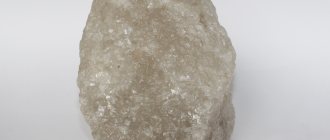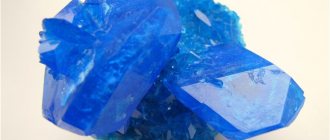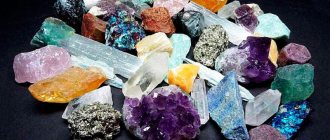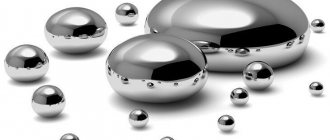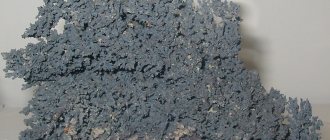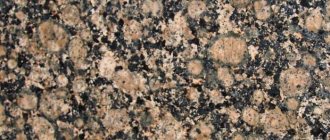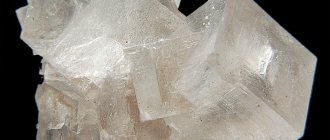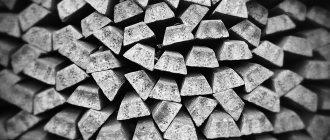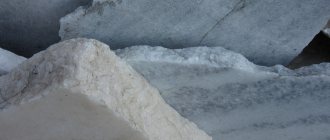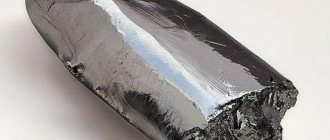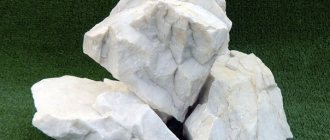Often we use an item and do not know its origin. Thus, pumice, familiar to everyone, is present in many people’s bathrooms, but some ordinary people have no idea that it is a volcanic mountain rock. Erupting from great depths, magma on the surface turns into flowing volcanic lava, slowly solidifying. What kind of interesting stone is that does not sink in water and does not burn in fire?
History: legends and facts
According to ancient legends, the Greek goddess Aphrodite, emerging from the sea, left her traces on the shore in the form of sea foam. Time passed, and the foam turned to stone, absorbing all its power. The ancient Greeks wandered along the coastal strip and looked for pumice; it was believed that the stone protected against misfortunes and adversity, so it was worn as a talisman.
The scientific version of the origin of pumice is more prosaic. Pumice is lava erupted through volcanic eruptions. Gases and gaseous mixtures evaporated on the surface, foaming the lava. Thanks to these processes, that same volcanic pumice was formed.
But in ancient times people did not have such knowledge in the field of geology and were very religious. They believed in the beneficial effects of porous stone. It is known that young girls of Ancient Hellas, in order to charm on their wedding night, gave their grooms talismans made of pumice. The young men cut out figurines of Aphrodite from it in the hope that the goddess in this image would help in love affairs.
One interesting fact is known about pumice. Researchers sometimes found records of floating islands in the ship logs of ancient sailors. This was not a big deal until the underwater Kermadec volcano erupted in July 2012. This happened off the coast of Samoa. After the eruption, a huge floating island with an area of 500 km2 was formed. After a few months, currents, wind and waves broke it into many pieces. The captains' reports about giant floating islands were confirmed.
By the way, biologists considered the formation of such islands to be one of the options for the entry of certain species of animals and plants onto other continents.
The islands kept afloat due to the low density of pumice, but over time, gaseous mixtures in the pores of the rock dissolved in water and the density increased, as a result of which they began to sink.
Today, scientists are trying to figure out the process of the formation of such islands, since their size exceeds the amount of pumice ejected from volcanic vents by several orders of magnitude. Unraveling these and other mysteries will help explain how these structures could influence the evolution of life on the planet in the past.
History: legendary and natural
The process of pumice formation is reflected in ancient Greek myths and studied by scientists:
- According to legend, the goddess of love and beauty Aphrodite, emerging from the water, left a trail of sea foam on the shore. Over time, the foam turned to stone, absorbing divine power. Ancient Greek women searched for her along the coast. And having found it, they kept it as a talisman.
- The scientists' version is more prosaic. Pumice is a mass erupted by a volcano. Gases, dissolving during the eruption process, foam it, creating porosity. If not for these gas bubbles, the mineral would have become obsidian - a monolithic volcanic glass.
The glassy rock pumice is solidified lava foam.
The process of its formation is reminiscent of the “eruption” of champagne or soda when opening a bottle. Only the liquid has foam, and the volcano has pumice stone.
Is pumice dangerous?
As already noted, pumice is an igneous rock, and therefore poses a danger to people during volcanic eruptions. According to research, about 600 million people in the world live in close proximity to active volcanoes. At any moment they can become deadly to people. Statistics show that over 40 years, an average of 900 people per year died as a result of eruptions. Although everyone knows the death of Pompeii, when due to the eruption of the awakened volcano Vesuvius, according to the most conservative estimates, about 15 thousand people died, the cause of whose death, in particular, was that same pumice in the form of ash.
Today, flights of all types of aircraft are prohibited in areas where powerful volcanic eruptions occur. The reason for such bans was the threat of pumice dissolved in the atmosphere getting into the engines, which “wipes” the engine and clogs the equipment.
During the eruption of Mount Pinatubo, people were evacuated in advance, and temporary camps were organized for many elderly and sick people. As a result of the ash fall, the entire earth was covered with a multi-meter layer. Due to the large amount of ash that settled on the roofs of the buildings, they collapsed, burying everyone who was inside the premises.
Ash-covered reservoirs do not receive the necessary light and oxygen, as a result of which the inhabitants die.
Natural “rafts” of pumice in rivers threaten the demolition of dams and dams. Flooding may occur. The movement of ships on such bodies of water threatens abrasion of the hulls and rotating propeller blades.
Physico-chemical characteristics
Pumice is a porous glassy rock with low density.
It is represented by long-fiber and coarse-bubbled glass of acidic composition. In the process of formation, it acquires specific distinctive features that distinguish it from other rocks. Density ranges from 0.5 to 1.4 g/cm3. The hardness is low, on the Mohs scale - 5. Buoyancy in water is ensured by the composition of the pores up to 90%. Fire resistant, inert to many chemicals. The color is varied and depends on the conditions of genesis. It differs from volcanic tuff in its homogeneous composition.
Mineral composition: quartz up to 70%, feldspar (orthoclase) up to 30%. Often contains plagioclase inclusions. The texture is foamy and spongy. The fracture is uneven and conchoidal. Gloss – matte. Color – from white to yellowish, less often pink. At a temperature of 1400°C it softens.
Description
Usually the mineral is identified by its light shades. But the color range extends all the way to black (such specimens are saturated with iron). Beautiful blue or yellow masses are created by impurities of nickel, titanium or calcium.
Igneous rock is light, does not sink, and crushes effortlessly. It can be finely or coarsely porous. The structure resembles cells, bubbles, foam or fibers.
Its origin and formula are related to the minerals of the pyroxene group.
How is pumice formed?
Volcanic pumice is formed when lava boils violently due to the release of gases and vapors released during an eruption. The formation can be represented by the example of a pressurized soda splashing out of a bottle. It is these gases that prevent the formation of obsidian (volcanic glass). It has different colors, composition and appearance. Rock occurrence in nature occurs in the form of streams, small covers and domes. The distribution of pumice is determined by the area of extinct or active volcanoes. There are varieties:
- liparitic;
- basalt;
- andesitic;
- trachytic.
Place of Birth
Pumice rock is mined all over the world. The deposits are confined to the products of volcanic activity, therefore they are mainly located near extinct volcanoes. In Russia, development has been developed in the Caucasus; large reserves are known in Kamchatka and the Kuril Islands. The form of occurrence of pumice is different. Rock quality is assessed based on two criteria: porosity (pore size) and type of substance. Pumice is a fairly fragile material; it is destroyed over time due to weathering and pressure from layers. Therefore, it is often extracted in the form of bulk material.
The deposits in Kamchatka are among the highest quality, but the profitability of production leaves much to be desired due to the difficulty of transporting minerals. Mining is also carried out in Europe, in particular in Italy, Germany, and Armenia.
It is mined by open pit mining using excavators. Individual high-quality rock outcrops are mined by hand by single miners.
Deposits and where production takes place
The mineral is found in places of ancient volcanic activity. That is, all over the planet.
Main producers: Armenia, Italy (islands of the Tyrrhenian Sea), Germany, New Zealand.
Russian deposits of volcanic pumice are concentrated in Kamchatka and the Caucasus.
Raw materials from different deposits differ in color and texture. It is mined using excavators. Single miners extract the mineral by hand.
Pumice in nature
Artificial versus natural pumice
It is unprofitable to counterfeit the material due to its low cost of sale, as well as its wide distribution. Despite this circumstance, an artificial variety has been created with its own pros and cons.
The damage caused to skin areas during hygiene procedures often becomes inflamed.
Natural
Natural volcanic pumice is characterized by impeccability in environmental matters, porosity and density. Wounds during use do not cause inflammation of the skin. Not contraindicated for allergy sufferers.
The downside is water permeability, since long-term moisture retention promotes the spread of bacteria and germs.
Artificial
Artificial analogues do not absorb moisture, are distinguished by a wide palette of colors, and are durable. Recommended for people who suffer from fungal diseases of the feet and nails.
Although there are some minor disadvantages: it is heavier compared to natural stone, and you can come across low-quality products that crumble badly.
In addition, artificial pumice is cheaper, which makes it attractive to buyers.
Production is carried out in different ways at metallurgical plants. The raw material is the slag remaining after the melting of metals. Porosity is achieved by abruptly placing a hot composition into water pools. Water under the influence of high temperatures turns into steam, which swells the mass, creating the finished product.
Crushed glass is added to the composition by fusing quartz sand with cementitious additives. In this way, grain uniformity and sufficient hardness are achieved.
Where is it used?
Pumice is distinguished by its abrasive properties. In Ancient Greece, marble statues were polished using pumice, giving it a perfect smoothness. Today, the range of applications in various fields of industry, decoration and medicine is quite wide.
Industry
Among the industrial uses, pumice is used as an additive in concrete. So in construction it is used as a filler in the production of pumice concrete and pressed wall blocks. In chemistry and petrochemistry they are used for the purification of oils and the synthesis of organic substances. Added to dynamite to facilitate initiation of the explosive.
Glassmakers value pumice as a source of raw materials for their work.
Jewelry and decorative arts
In the decorative arts, pumice is famous for its floral compositions. Thanks to the absorption of moisture, entire works of flowers are arranged in pumice bowls, filling the spaces selected in the sample with moss. Stone cutters make beads, balls, candlesticks and various figurines.
Household sphere
Amateur gardeners appreciated the quality of the absorbent composition of the breed. In hydroponics, when growing various crops, it replaces soil, which does not require constant change. Today, many cleaning products cannot do without adding abrasive pumice powder to their composition. It is worth noting that in ancient times they washed with pumice instead of soap.
In cosmetology, it is used as a means to remove rough skin on the feet and as a body scrub. Cosmetic products based on powdered pumice are non-toxic and have hypoallergenic properties.
In medicine
A soft abrasive is used in tooth powders and pastes in dentistry, first crushed to a powdery consistency. It is effective when used in peeling procedures with a gentle effect. Women often use products based on pumice powder for hair removal. After soaking a small amount of such powder with a soap solution in warm water, rub it in a circular motion over the skin.
In dental procedures, it is indispensable for polishing acrylic dentures.
In cleaning systems
Few people thought that pumice is used to purify water. It is an excellent deodorizer and natural filter for such needs. Filters using such cartridges are used at the first stages of purification, trapping large impurities not only of mechanical formations, but also of organic substances. The only minor drawback is the frequent change of cassettes, since long-term use leads to the growth of microorganisms. But this drawback is also inherent in other analogues.
What is pumice? Properties of pumice. Application of pumice
Description and properties of pumice
When we pronounce the word “ pumice ”, the following image is created in our minds: a piece of hewn blast furnace slag or a block of foamed concrete. These are all, of course, artificial materials, and have only the most minimal resemblance to real natural pumice.
Natural pumice is a light glassy mass erupted by a volcano and foamed due to gases dissolved in it. It is these gases, acting as bubbles on the surface of pumice, that prevent it from turning into volcanic glass - obsidian.
So, frozen lava foam is a rock - pumice . Pumice stone looks dense, but is actually porous and lightweight. Pumice does not sink in water
In its composition and appearance it resembles pumice slag . Their similarities are in their porous structure and light weight. But the difference is significant: in pumice the arrangement of bubbles is small and ordered, and the chemical composition is similar to felsite.
Origin of pumice
The formation of pumice is similar to the process when carbonated water escapes from a bottle. It also resembles a volcanic eruption, but in everyday conditions. The release of gases is promoted by a decrease in pressure. But if in the case of mineral water foam is formed, then from lava - volcanic pumice , a material that is very necessary and useful.
Different pumice comes from different deposits. It is distinguished by its texture. To use pumice, it is important what its pore size is and what the nature of the glassy substance that composes it is.
Based on pore size, pumice can be fine- or large-pore. At the same time, its structure is also divided into specific types:
- Cellular
- Foamy
- Fibrous
- Bubble
The color range of natural pumice is also different: from white to black. Black pumice contains a large amount of iron. Blue pumice is also found ; it is formed as a result of the combination of silicon with nickel, calcium or titanium.
Types of pumice
Currently, two types of pumice : natural and artificial. When choosing, preference is given to the first one, since it has a number of significant advantages. Natural pumice is more porous and lighter than artificial pumice.
In addition to these characteristics, such pumice is environmentally friendly; even allergy sufferers can use it without any fear. And even if you accidentally get hurt, there will be no inflammation on the skin. Natural pumice for feet does not break or crumble.
But not everything is so rosy and rosy. Natural pumice also has disadvantages: it quickly absorbs moisture and takes a long time to dry. The result is microbes living in the pores. Therefore, do not forget to ensure that the pumice is dry.
There are a variety of artificial pumice stones . They do not swell with water and will not become a breeding ground for microbes; they retain their original shape and appearance for a long time. But artificial pumice stone crumbles badly, and if the skin is damaged, it will cause redness or even an inflammatory process.
Application of pumice
Pumice is used in important and significant industries. Her role is invaluable in:
- Cosmetics
- Deodorization
- Construction
- Filtration of water and fish ponds
- Gardening
- Metalworking and glass processing
- Polishing teeth
As for construction, crushed stone made from slag pumice has found widespread use. It is used to make lightweight concrete.
And also when insulating concrete blocks. Microgranulated pumice is an excellent cement additive and is mixed with lime to create a mixture similar in structure to plaster.
In addition, slag pumice is popular when drilling oil wells. It weighs little, but at the same time has excellent density, which is why it is used there as cement. But still, pumice stone is most widely used in everyday life and cosmetic procedures.
pumice powder with a fraction of a few millimeters are ideal . They will also be an excellent solution for polishing surfaces, including cars, glass and mirrors.
Pumice is also a key ingredient in hand wash. It is added in crushed form to soften it and in some toothpastes.
The importance of pumice in the manufacture of various industrial parts is invaluable. Examples of uses for pumice include deodorant rollers, golf balls, pewter mugs, and silverware.
Well, the most popular is the use of pumice as a foot care product. It is relevant for all times. You don't need a new-fangled scrub to soften rough skin on your feet and remove dead cells; you can simply use a pumice brush or pumice file .
It is irreplaceable in eliminating calluses and corns. Penza for heels remains the cheapest and most effective way of care at all times. And most importantly, there are no special recommendations on how to use pumice .
, electric pumice has become fashionable . This is a special machine, the so-called pumice stone for pedicure , which will allow you to quickly and efficiently care for your feet at home. For convenience, several special attachments have been developed.
The speed varies, but there are also those whose roller rotates up to 30 revolutions per second. Changing the used roller is easy, just one click is required. The handle is comfortable. The machine comes with a cleaning brush, batteries and instructions, so it won’t be too difficult to figure out.
In addition to pumice for pedicure, there is also pumice for cuticles . It resembles a pencil with a thick end; it needs to be slightly wetted before touching the nail. This pumice stone quickly and painlessly removes unnecessary cuticles; you don’t have to trim them.
Pumice price
buy pumice at any pharmacy in the city or other locality where you live. You don’t need to go around them all, just go to the Internet and type the desired entry in a search engine. From the list presented, select the one that is most suitable for you in terms of characteristics and price. And also choose a convenient delivery method.
On the websites you can get advice on the use of pumice, check availability and even make a reservation if you are afraid that you will not get the product you like.
You can also find the product you are interested in in the online store. The price of pumice is not high. The cost of natural pumice is from 170 to 290 rubles. Moreover, sometimes the online store offers tempting discounts on its products. Electric pumice stones are much more expensive, their cost ranges from 700 to 1300 rubles.
Pumice is a volcanic lava rock that has found its application in various areas of human life. It is irreplaceable in construction, gardening, and cosmetology.
How to wear and care
Jewelry made from pumice has not become widespread in jewelry production. The material is too fragile, afraid of impacts, and does not tolerate careless treatment. Nevertheless, sometimes jewelers make crafts from this stone. The product is polished and often coated with a compound that prevents moisture from getting inside, and the appearance of such beads and balls takes on an attractive appearance.
Care consists of careful wearing. Due to its abrasive properties, pumice necklaces should not be stored with other stones, such as fluorite.
Magic properties
Varieties of pumice reveal a person's inner resources, helping people increase self-esteem and their own attractiveness. Indian teachings say this. For example, the energy of the lower chakra - Svadhisthana, which is responsible for the emotional state, is enhanced if you perform regular massages in the pelvic area. It is believed that this procedure distributes concentrated vortex energy throughout the body.
Particularly useful for women during periods of hormonal imbalances and stress.
Shyness when communicating will disappear if you wear a necklace made of pumice, and in each specific case a different color of the beads is required. Due to its absorbent properties, the effect is enhanced if you use various scented products with pheromones. Jewelry with pearls would be an ideal option.
Contact lithotripsy of stones
The method is effective for stones up to 2.5 cm of any density. The patient's weight does not matter. A thin optical device, an endoscope, is inserted through the urethra under anesthesia. Having reached the ureter or kidney, the doctor destroys the calculus itself. The surrounding tissues are not damaged. The entire operation is carried out under visual control.
Types of impact on stone:
- Ultrasonic - suitable for low-density stones, crushes them to dust, which is immediately removed through aspiration.
- Pneumatic - used for dense stones; larger fragments are removed with a special loop immediately during the procedure.
- Electrohydraulic - used for small stones 10-15 mm in size, destroys using a miniature electric arc, without damaging surrounding tissue.
- Laser lithotripsy - the beam is delivered through an optical probe, destroys the hardest stones of any size; the fragments are small, 1-3 mm, come out on their own.
In order for the fragments to come out quickly and painlessly, the doctor installs a thin flexible tube - a stent - into the ureter. It is removed after 7–10 days.
With such operations, complications and exacerbation of chronic pyelonephritis are very rare. On the second or third day, the patient is discharged from the clinic and begins daily activities.
Therapeutic effect
The healing power of pumice lies not only in wearing jewelry. Having a small garden, you can create a cozy and quiet corner where small flower arrangements are placed in pumice pots. And if you use natural stone as a building material for a fountain, then harmony and tranquility in moments of solitude will be guaranteed. When viewing such relaxing compositions, one important condition is necessary - the stream of water should be directed strictly upward, symbolizing indomitable energy.
Hindus almost always use polished pumice balls during meditation. This ancient people, dating back thousands of years, knows a lot about medicinal properties. For many centuries, this method of meditation has been passed down from generation to generation.
Price
The price for jewelry made from natural volcanic material is quite reasonable. A necklace without the inclusion of precious metals, depending on the size of the beads, varies from 500 to 1000 rubles. Individual beads are traded from 100 rubles. If the jewelry is complemented with pearls or other inserts, then the cost increases by an order of magnitude. On average, such products start from 5 thousand rubles.
Bracelets are presented in the price range from 500 rubles, and with the insertion of a meteorite stone from 2 thousand rubles and above.
Remote (extracorporeal) lithotripsy of kidney stones
Does not require any skin incisions. Crushing is performed using the shock wave method using a special apparatus - a lithotripter. The crushed stone fragments are then removed outside on their own.
Features of the method:
- Stones of low and medium density, ranging in size from 5 to 20 mm, can be treated;
- requires two to five sessions of shock wave lithotripsy, with a break of two to three weeks;
- for ureteral stones, anesthesia is not necessary, and the crushing of kidney stones takes place under general anesthesia;
- The method is not suitable for people with grade 2–3 obesity, since a large fat layer makes it difficult to focus the shock wave.
External shock wave lithotripsy is the most gentle method for removing kidney and ureteral stones. Nevertheless, we must remember that wave impulses moderately damage the tissues surrounding the stone. Salt fragments sometimes pass through the ureter painfully and can cause renal colic.
